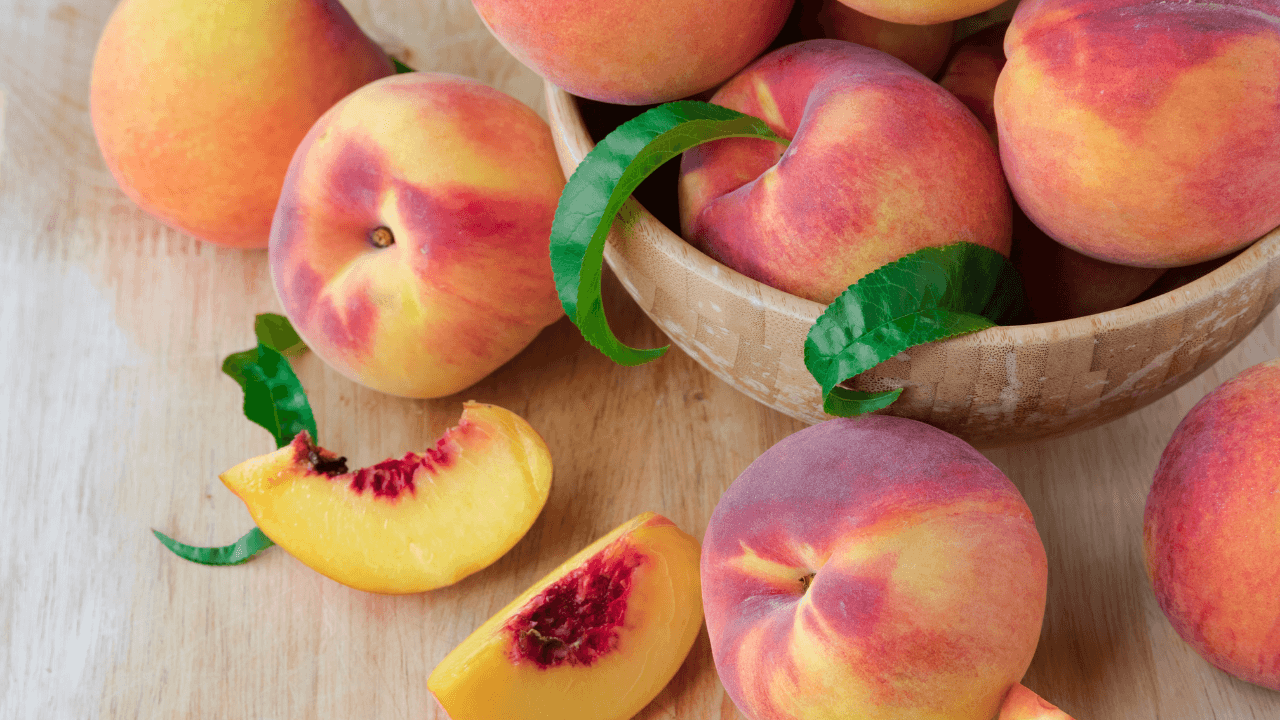We sure you’ve been questioning yourself sometimes, ‘Can Dogs Have Peaches?’. Peaches can be a delicious and healthy treat for dogs when served correctly. Rich in essential vitamins and low in calories, they offer health benefits but require careful preparation to ensure your pet’s safety.
While peaches can provide some health benefits for your furry friend, it is essential to understand the potential benefits and risks of this sweet fruit. Here’s what you need to know about incorporating peaches into your dog’s diet.
Are Peaches Good for Dogs?
The short answer is yes, dogs can eat peaches. However, some essential points must be considered to ensure their safety and well-being.
Peaches can offer our canine companions several potential benefits when introduced into their diet safely and controlled. While they should be given in moderation, the nutritional content of peaches can contribute positively to your dog’s overall health. Here are some of the benefits of feeding your dog peaches:
1. Rich in vitamins 🍑
Peaches are a good source of vitamins A and C. Vitamin A is essential for maintaining healthy skin and coat and promoting good vision. Vitamin C acts as an antioxidant, supporting the immune system and helping to combat free radicals that can damage cells.
2. Dietary fiber 🍽️
Peaches contain dietary fiber, which can aid in digestion and help regulate bowel movements. This can be particularly beneficial for dogs with mild digestive issues or irregularities.
3. Low in calories
Peaches are relatively low in calories, making them a healthy snack option for dogs as long as they are consumed in moderation. This can be helpful for dogs on a weight management program.
4. Hydration 💧
Peaches have a high water content, which can help keep your dog hydrated, especially during hot weather. Proper hydration is crucial for overall health and can prevent urinary tract infections.
5. Taste and variety 🎉
Dogs, like humans, appreciate variety in their diet. Offering your dog small amounts of peach as an occasional treat can add flavor diversity to their meals, making mealtime more exciting.
Peaches should be prepared and served correctly; remove the pit and any harmful substances, and gradually introduce peaches to monitor your dog’s tolerance.
Proper Nutrition for Puppies
Understanding what foods are safe and beneficial for your new puppy’s growth and health is key. Peaches can be introduced as a treat in moderation, but the primary diet should be high-quality puppy food that meets all their nutritional needs.
Potential Risks of Feeding Peaches to Dogs
Peaches can be rotten for dogs if not handled correctly or given in excess. Feeding peaches to dogs comes with risks such as:
- Cyanide poisoning from the pits
- Potential allergies
- Digestive upset
Always remove the peach pit, as it contains cyanide, which is extremely harmful to dogs. Monitor your dog for allergic reactions like itching or swelling, and be cautious with the amounts given, especially if your dog has a sensitive stomach.
Always consult your vet if you notice any adverse reactions after feeding peaches to your dog.
Tip: To save high-cost vet visits, consider dog insurance plans for your pet.
How Many Peaches Can Dogs Eat?
The quantity of peaches your dog can safely eat depends on their size and individual tolerance. As a general guideline, small dogs should consume no more than a few small slices or chunks of peach, while larger dogs can have a bit more.
Always start with a small amount and observe how your dog reacts. If you notice any adverse reactions, such as digestive issues, discontinue feeding peaches immediately.

How to Safely Introduce Peaches into Your Dog’s Diet
Feeding your dog peaches safely requires some simple but important steps:
- Choose ripe and fresh peaches: select fresh, ripe peaches that are free of mold and bruises. Organic peaches are preferable to minimize exposure to pesticides.
- Wash and optional peel: thoroughly wash the peach to remove contaminants. Peeling is optional but can reduce the risk of pesticide ingestion.
- Remove the pit: ensuring the pit is completely removed is crucial, as it contains harmful cyanide.
- Cut into small pieces: slice the peach into small, manageable pieces to prevent choking and ease digestion.
- Start with a small amount: introduce peaches by offering your dog a single small slice or piece, allowing you to monitor their reaction and ensure they tolerate it well.
Peaches can be a delightful treat for your dog, offering both hydration and nutritional benefits.
However, it’s vital to prepare them safely by removing the pit and introducing them gradually into your dog’s diet. Always prioritize your dog’s well-being and consult your veterinarian if you have concerns about feeding peaches or any new food to your dog.

FAQs
Can I give my dog peach-flavored treats?
While natural peaches are safe when properly prepared, peach-flavored treats like candies or gums often contain xylitol or artificial sweeteners that are toxic to dogs. Always check the ingredients list for any harmful additives before giving such treats to your pet.
What are the signs of cyanide poisoning in dogs?
Signs of cyanide poisoning in dogs can include difficulty breathing, dilated pupils, excessive salivation, and shock. If you suspect your dog has ingested peach pits and is showing these symptoms, contact a veterinarian immediately.
How can I tell if my dog is allergic to peaches?
Allergic reactions in dogs may manifest as gastrointestinal upset, itching, or respiratory distress. If you notice your dog scratching excessively, developing hives, or having difficulty breathing after eating peaches, consult your vet promptly.
Are there any other fruits that provide similar benefits without the risks?
Apples (without seeds) and blueberries are excellent alternatives to peaches. They offer similar nutritional benefits, such as fiber, vitamins, and hydration, but with fewer risks. Always remove apple seeds containing cyanide before feeding them to your dog.
How often can I safely give my dog peaches?
Peaches should be treated as an occasional snack, not a regular part of your dog’s diet. Depending on your dog’s size and dietary needs, a small amount once a week during peach season is typically safe.
References:
For further reading on the topics discussed in this article, consider the following resources:
- FDA Investigates Animal Illnesses Linked to Jerky Pet Treats—This FDA report provides insights into the risks associated with certain pet treats, including those flavored with fruit. It highlights the importance of choosing safe and healthy options for your pets.
- Treat Options for Dogs and Cats Without Unbalancing Their Diet—This is an informative guide on incorporating treats like peaches into your pet’s diet without disrupting its nutritional balance.
- Prunus persica, common peach—This detailed overview of the peach, including its nutritional profile and potential health benefits, can help you understand how to include peaches in your dog’s diet safely.
- Potentially Dangerous Items for Your Pet – This resource lists common household items and foods that can pose risks to pets, including peach pits, underscoring the importance of proper preparation and awareness of potential hazards.






maybe my dog likes peaches and I don’t know about it😂😂😂😂
I’ve given my dog small amounts of peaches occasionally, but I always remove the pits and skin